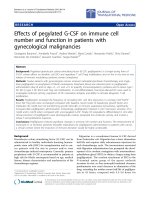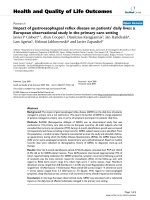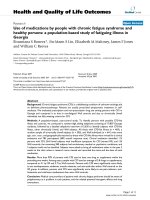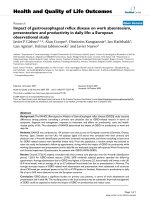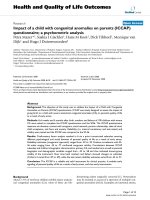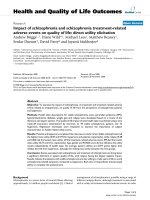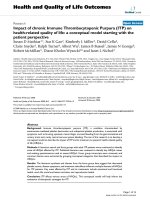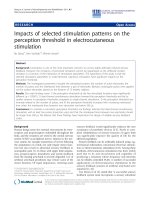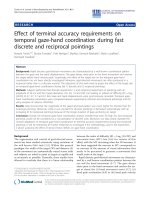báo cáo hóa học: " Impact of gastroesophageal reflux disease on work absenteeism, presenteeism and productivity in daily life: a European observational study" doc
Bạn đang xem bản rút gọn của tài liệu. Xem và tải ngay bản đầy đủ của tài liệu tại đây (360.88 KB, 7 trang )
BioMed Central
Page 1 of 7
(page number not for citation purposes)
Health and Quality of Life Outcomes
Open Access
Research
Impact of gastroesophageal reflux disease on work absenteeism,
presenteeism and productivity in daily life: a European
observational study
Javier P Gisbert*
1,2
, Alun Cooper
3
, Dimitrios Karagiannis
4
, Jan Hatlebakk
5
,
Lars Agréus
6
, Helmut Jablonowski
7
and Javier Nuevo
8
Address:
1
Department of Gastroenterology, Hospital Universitario de la Princesa, Madrid, Spain,
2
Centro de Investigación Biomédica en Red de
Enfermedades Hepáticas y Digestivas (CIBEREHD), Barcelona, Spain,
3
Bridge Medical Centre, Crawley, West Sussex, UK,
4
Department of
Gastroenterology, Athens Medical Center, Athens, Greece,
5
Institute of Medicine, Haukeland University Hospital, Bergen, Norway,
6
Center for
Family and Community Medicine, Karolinska Institutet, Huddinge/Stockholm, Sweden,
7
Klinikum Salzgitter GmbH, Salzgitter, Germany and
8
AstraZeneca, Madrid, Spain
Email: Javier P Gisbert* - ; Alun Cooper - ; Dimitrios Karagiannis - ;
Jan Hatlebakk - ; Lars Agréus - ; Helmut Jablonowski - ;
Javier Nuevo -
* Corresponding author
Abstract
Background: The RANGE (Retrospective ANalysis of GastroEsophageal reflux disease [GERD]) study assessed
differences among patients consulting a primary care physician due to GERD-related reasons in terms of:
symptoms, diagnosis and management, response to treatment, and effects on productivity, costs and health-
related quality of life. This subanalysis of RANGE determined the impact of GERD on productivity in work and
daily life.
Methods: RANGE was conducted at 134 primary care sites across six European countries (Germany, Greece,
Norway, Spain, Sweden and the UK). All subjects (aged ≥18 years) who consulted with their primary care
physician over a 4-month identification period were screened retrospectively, and those consulting at least once
for GERD-related reasons were identified (index visit). From this population, a random sample was selected to
enter the study and attended a follow-up appointment, during which the impact of GERD on productivity while
working (absenteeism and presenteeism) and in daily life was evaluated using the self-reported Work Productivity
and Activity Impairment Questionnaire for patients with GERD (WPAI-GERD).
Results: Overall, 373,610 subjects consulted with their primary care physician over the 4-month identification
period, 12,815 for GERD-related reasons (3.4%); 2678 randomly selected patients attended the follow-up
appointment. Average absenteeism due to GERD was highest in Germany (3.2 hours/week) and lowest in the UK
(0.4 hours/week), with an average of up to 6.7 additional hours/week lost due to presenteeism in Norway. The
average monetary impact of GERD-related work absenteeism and presenteeism were substantial in all countries
(from €55/week per employed patient in the UK to €273/patient in Sweden). Reductions in productivity in daily
life of up to 26% were observed across the European countries.
Conclusion: GERD places a significant burden on primary care patients, in terms of work absenteeism and
presenteeism and in daily life. The resulting costs to the local economy may be substantial. Improved management
of GERD could be expected to lessen the impact of GERD on productivity and reduce costs.
Published: 16 October 2009
Health and Quality of Life Outcomes 2009, 7:90 doi:10.1186/1477-7525-7-90
Received: 20 April 2009
Accepted: 16 October 2009
This article is available from: />© 2009 Gisbert et al; licensee BioMed Central Ltd.
This is an Open Access article distributed under the terms of the Creative Commons Attribution License ( />),
which permits unrestricted use, distribution, and reproduction in any medium, provided the original work is properly cited.
Health and Quality of Life Outcomes 2009, 7:90 />Page 2 of 7
(page number not for citation purposes)
Background
Gastroesophageal reflux disease (GERD) is a condition in
which reflux of gastric contents into the esophagus causes
troublesome symptoms such as heartburn and regurgita-
tion and/or other complications, including reflux
esophagitis [1]. In addition to esophageal manifestations,
patients may also experience extraesophageal symptoms
such as cough and hoarseness [2]. Current estimates sug-
gest that GERD affects around 10-20% of the European
population [3,4], with many individuals reporting
marked impairment of their health-related quality of life
(HRQOL) and general well-being [5-8]. Productivity,
both during leisure time and while working (presentee-
ism), is also affected [8-12]. Associated costs can be sub-
stantial, with one US study indicating that indirect costs
(as a result of presenteeism and/or due to absenteeism)
accounted for 19% of the mean incremental cost of GERD
to employers [13]. To date, however, few studies have
evaluated the impact of GERD on productivity, and asso-
ciated costs, from a European observational perspective.
The RANGE (Retrospective ANalysis of GERD) study was
designed to assess differences among patients consulting
with a primary care physician for GERD-related reasons in
several European countries. Symptom profile, diagnosis
and management, as well as effects on productivity, costs
and HRQOL, were examined. Here, we outline the impact
of GERD on productivity as part of the RANGE study,
while other results of the RANGE study are published else-
where [14,15].
Methods
Study design and patients
RANGE (AstraZeneca study code: D9612L00114) was a
multinational, observational programme that was con-
ducted as a series of parallel, locally managed studies at
134 primary care sites across six European countries (Ger-
many, Greece, Norway, Spain, Sweden and the UK). The
programme was conducted in accordance with the ethical
principles described in the Declaration of Helsinki, and
was approved by local ethics committees.
At the start of the study, all adult subjects (≥18 years) who
consulted with their primary care physician over a 4-
month identification period were screened retrospectively
for possible inclusion in the study (index visit). Based on
medical record review, patients who had consulted at least
once for GERD (with or without treatment, and regardless
of whether GERD was the main reason for the visit) were
identified. Patients were considered to have consulted for
GERD-related reasons if they met at least one of the fol-
lowing criteria: they reported troublesome heartburn and/
or regurgitation; GERD had been diagnosed by endoscopy
(presence of esophagitis), esophageal pH monitoring
(pathological esophageal pH) or by the presence of symp-
toms only (heartburn and/or regurgitation); GERD com-
plications were recorded (including haemorrhage,
stricture or Barrett's metaplasia); or they were prescribed
proton pump inhibitors (PPIs), H
2
receptor antagonists
and/or antacids for GERD. Exclusion criteria included:
prophylactic treatment with PPIs to prevent ulcers in
patients taking non-steroidal anti-inflammatory drugs
(NSAIDs); PPI use to heal an NSAID-induced ulcer; PPI
treatment for Helicobacter pylori eradication; and participa-
tion in another clinical study.
From the GERD study population, a randomly selected
sample was invited by letter or telephone call to partici-
pate in the study (selection of participants was made using
the random number generating function of Microsoft
Excel, adapted to random without replacement). Patients
who agreed to participate were asked to attend a clinic
visit (visit 1) at which a range of data were collected dur-
ing an interview with the physician and from medical
record review, including: demographics, medical history,
reason for initial consultation (e.g., new symptoms in
patients who had never experienced GERD symptoms pre-
viously, recurrent or persistent symptoms, follow-up visit
in an asymptomatic patient) and GERD symptoms during
the previous 7 days (frequency and intensity). Patients
were also asked to complete the Work Productivity and
Activity Impairment Questionnaire for patients with
GERD (WPAI-GERD) [9,11]. This validated questionnaire
uses single items to assess absence from work, presentee-
ism and productivity during daily life (unpaid, nonprofes-
sional activities) in relation to reflux symptoms, with a 7-
day recall period. Responses to productivity questions are
graded on a 10-point scale, where higher numbers repre-
sent a greater degree of impairment.
Statistical methods
Due to the descriptive objectives of the RANGE study,
there were no hypotheses to test with statistical methods
to predetermine a needed sample size. Therefore, the
choice of target sample was pragmatic, based partly on the
need to provide local studies with adequate power to
explore the local situation and allow participating coun-
tries to fulfil their recruitment agreement. Predefined sam-
ple size for Germany, Greece, Norway and Spain was 500
patients (allowing to obtain two-sided 95% confidence
intervals for single proportions using the large sample
normal approximation that will extend 4.4% from the
observed proportion for an expected proportion of 50%
[the worst possible case]). In the same way, predefined
sample size for Sweden and UK was 300 patients (allow-
ing to obtain confidence intervals that will extend 5.7% in
the worst possible case).
Reduced work productivity was measured using the
WPAI-GERD questionnaire in two components: the
number of hours absent from work (absenteeism) was
included as one outcome measure, while the number of
Health and Quality of Life Outcomes 2009, 7:90 />Page 3 of 7
(page number not for citation purposes)
work hours lost due to reduced productivity while work-
ing (presenteeism) was calculated as the number of hours
worked multiplied by the percentage reduction in produc-
tivity. The work time missed due to GERD (%) was calcu-
lated as [hours absent from work/(hours absent from
work + hours actually worked)] multiplied by 100. The
lost work productivity score was calculated as [(hours
absent from work + percent reduced productivity while
working multiplied by hours actually worked)/(hours
absent from work + hours actually worked)] multiplied by
100.
Reflux-related productivity losses were transformed into
monetary values by multiplying the number of hours lost
by the most recent hourly labour cost, by country (accord-
ing to Eurostat [Statistical Office of the European Com-
munities, Luxembourg]). The monetary value of hours
absent was thus calculated as hours absent from work
multiplied by the hourly labour cost, and the monetary
value of work hours lost due to presenteeism was calcu-
lated as work hours lost due to presenteeism multiplied
by the hourly labour cost. Values are shown in Euros (€)
for ease of comparison.
Results
Patients
Overall, 373,610 subjects consulted with their primary
care physician at 134 centres over the identification
period, of whom 12,815 (3.4%) did so at least once for
GERD-related reasons. From the latter population a subset
of 4845 randomly selected patients were invited to partic-
ipate in the study; 2678 (55%) attended for consultation.
The remainder were either non-contactable (n = 612),
non-attendees (n = 196) or declined participation (n =
340), while 1019 patients were not invited on the basis
that by-country samples sizes were reached. Demograph-
ics and clinical characteristics of participating patients, by
country of residence, are presented in Table 1. The profile
of patients was generally similar across the six countries
surveyed; 53-61% were women and mean age was 53-60
years. Recurrence of GERD symptoms after a period of
remission was the most common reason for the index visit
in all countries, with the exception of Spain and Sweden
(follow-up of an asymptomatic patient). Newly present-
ing patients with first occurrence of GERD symptoms
accounted for 16.7% of the overall study population,
ranging from 8% of consulting patients in Norway to 36%
of consultations in Greece. Some 43% of patients were
employed (including self-employed), ranging from 34%
in Spain to 52% in Sweden. Demographic and clinical
characteristics of such patients, by country, were generally
comparable to the total patient population, with the
exception that employed patients were typically younger
and less likely to be women (data not shown).
Impact of GERD on productivity
Work productivity
Among employed patients, the average number of work
hours lost due to GERD-related absenteeism was highest
in Germany (3.2 hours/week) and lowest in the UK (0.4
Table 1: Characteristics of participating patients with gastroesophageal reflux disease (GERD), by country of residence
Germany Greece Norway Spain Sweden UK
Number of patients 495 505 525 477 368 308
Women, n (%) 295 (59.6) 265 (52.5) 303 (57.7) 280 (58.7) 223 (60.6) 171 (55.5)
Mean age, years (SD) 58.6 (14.5) 52.5 (14.3) 57.2 (15.2) 59.8 (15.7) 56.2 (15.0) 56.4 (15.5)
Mean body mass index, kg/m
2
(SD) 27.7 (5.1) 27.4 (4.5) 26.9 (4.7) 28.0 (4.3) 27.5 (4.8) 28.0 (5.8)
Mean time since GERD diagnosis, years (SD) 3.5 (3.8) 2.3 (3.0) 6.1 (7.2) 4.5 (4.7) 6.0 (8.3) 5.7 (5.8)
Employed, n (%)* 192 (38.8) 258 (51.1) 233 (44.4) 161 (33.8) 196 (53.3) 132 (42.9)
Reason for index visit, n (%)
First occurrence of reflux symptoms 58 (11.7) 180 (35.6) 43 (8.2) 55 (11.7) 47 (12.8) 59 (19.2)
Recurrent symptoms after a remission period 256 (51.7) 211 (41.8) 176 (33.5) 137 (29.1) 82 (22.3) 94 (30.5)
Persistence of reflux symptoms 45 (9.1) 55 (10.9) 81 (15.4) 63 (13.4) 37 (10.1) 66 (21.4)
Follow-up visit (asymptomatic patient) 112 (22.6) 28 (5.5) 174 (33.1) 201 (42.7) 108 (29.4) 85 (27.6)
Other 30 (6.1) 15 (3.0) 51 (9.7) 15 (3.2) 94 (25.5) 8 (2.6)
Symptoms ≥2 days/week, n (%)
Heartburn 81 (16.4) 213 (42.2) 86 (16.4) 158 (33.1) 50 (13.6) NR
Regurgitation 75 (15.2) 216 (42.8) 85 (16.2) 147 (30.8) 42 (11.4) NR
No symptoms during previous week, n (%)
Heartburn 307 (62.0) 77 (15.2) 319 (60.8) 184 (38.6) 235 (63.9) NR
Regurgitation 346 (69.9) 91 (18.0) 343 (65.9) 202 (42.3) 245 (66.6) NR
Moderate-to-severe symptoms, n (%)
Heartburn 161 (32.5) 347 (68.7) 154 (29.3) 223 (46.8) 95 (25.8) NR
Regurgitation 124 (25.1) 289 (57.2) 127 (24.2) 204 (42.8) 91 (24.7) NR
NR = not recorded; SD = standard deviation.
* The employed category included 9 patients for whom employment details were missing, but who were assumed to be in employment as they
completed the Work Productivity and Activity Impairment Questionnaire for patients with GERD.
Health and Quality of Life Outcomes 2009, 7:90 />Page 4 of 7
(page number not for citation purposes)
hours/week), with an average of up to 6.7 additional
hours lost per week in Norway because of presenteeism
(Table 2). The proportion of time per week lost due to
GERD-related absenteeism ranged from a mean of 1.6%
in Sweden to 9.1% in Germany (Figure 1). Presenteeism
due to GERD led to mean losses of a further 9.5% in the
UK to 20% in Norway. Data were subject to large variabil-
ity, indicating that some respondents had more absences
and/or severe impairment of productivity due to GERD
than others.
The monetary impact of GERD-related work absenteeism
and presenteeism was substantial in all countries (Table 3
and Figure 2). Absenteeism-related costs were greatest in
Germany (mean €88/week per employed patient) and
lowest in the UK (€6/week per employed patient). Presen-
teeism led to somewhat higher costs than absenteeism,
ranging from an average of €50/week per employed
patient in the UK to €251 in Sweden. Total monetary
costs of hours absent plus hours lost due to presenteeism
were substantial; in Sweden, for example, the mean total
monetary value was €273/week per employed patient
(Table 3).
Daily life
Reduced productivity while carrying out activities of daily
life was also considerable, with patients experiencing
mean productivity reductions ranging from 15% in the
UK to 26% in Norway (Figure 1). Again, the data were
subject to marked variability, indicating that daily life was
impaired by GERD to a greater extent in some patients
than in others.
Discussion
The results of this analysis of the RANGE study show that
GERD has a significant impact on patients' work produc-
tivity, in terms of absenteeism and presenteeism
(decreased productivity while working). Furthermore,
patients also experienced a substantial reduction in pro-
ductivity in daily life. These findings, combined with the
considerable impact on patients' HRQOL observed in the
RANGE programme [14], help us to further understand
the burden associated with this disease. A structured
approach to management of GERD, tailoring therapy
according to patient need, may lessen this impact on pro-
ductivity and, in turn, reduce costs. One way to achieve
this might be to employ management tools such as GerdQ
[16], which evaluates the frequency of GERD symptoms,
sleep disturbance and use of over-the-counter medication
for heartburn and/or regurgitation. In turn, physicians
would be better able to quantify the impact of GERD and
tailor treatment accordingly.
Generally, Norway, in particular, as well as Sweden, had
the highest figures for reduced productivity while working
(presenteeism) and in daily life, and work time missed
due to GERD symptoms. The lowest figures for all produc-
tivity variables were consistently observed in the UK.
However, it should be noted that the data observed in this
report are subject to considerable variation between the
European countries surveyed. Overall, productivity losses
reported in this study are higher than those reported in
some previous studies. For example, data from a 2004 sur-
vey of US respondents with self-reported symptoms of
GERD, of whom 58% were employed, reported a 7.5%
reduction in work productivity and 0.9 hours of absentee-
ism per week [8], compared with up to 20% and 3.2
hours, respectively, in our study. This difference most
likely reflects the use of the generic, rather than GERD-
specific, version of the WPAI in the 2004 US survey and
internet-based recruitment of respondents with self-
reported GERD symptoms [8], rather than physician-diag-
nosed patients with GERD. Indeed, our results are similar
to previous studies in which productivity losses were
measured using the WPAI-GERD questionnaire [9,11]. In
one study, GERD symptoms led to 2.5 hours absent from
work, 23% reduced productivity due to presenteeism and
30% reduced productivity in activities of daily life [9].
Table 2: Mean (standard deviation) lost productivity due to gastroesophageal reflux disease (GERD), as measured using the Work
Productivity and Impairment Questionnaire for patients with GERD (WPAI-GERD), by country of residence
Germany Greece Norway Spain Sweden UK
Absenteeism, hours/week n 187 249 233 131 196 132
3.2 (8.8) 1.5 (5.1) 0.9 (4.7) 2.1 (7.1) 0.7 (3.4) 0.4 (2.7)
Presenteeism
(work hours lost/week due to reduced productivity while
working)
n 158 252 231 122 178 118
5.7 (8.6) 5.1 (7.7) 6.7 (6.2) 4.7 (8.2) 7.7 (7.5) 3.5 (6.6)
Lost work productivity score* n 189 248 231 120 196 131
16.7 (22.6) 12.3 (17.3) 18.1 (16.9) 17.1 (26.9) 17.0 (16.1) 9.1 (16.4)
*[(hours absent from work + percent reduced productivity while working multiplied by hours actually worked)/(hours absent from work + hours
actually worked)] multiplied by 100.
Sample sizes differ for each measure due to missing data, as a small number of patients completed the WPAI-GERD questionnaire (and were
therefore assumed to be employed) but did not record their professional details.
Health and Quality of Life Outcomes 2009, 7:90 />Page 5 of 7
(page number not for citation purposes)
It is of interest to compare GERD-related productivity
impairments in the RANGE study with findings from
other studies in patients with chronic disorders, which
have used modified versions of the WPAI questionnaire.
For example, in a study that used the allergy-specific ver-
sion of the WPAI questionnaire among a sample of
patients with allergic rhinitis, up to 40% of work time was
lost due to presenteeism (compared with 10-20% in
RANGE) and a loss of up to 50% in productivity during
daily activities was apparent (compared with 15-26% in
RANGE) [17]. However, no loss of work time due to
absenteeism was reported in this study (compared with 2-
9% in RANGE). Another study that used a version of the
WPAI modified for irritable bowel syndrome reported
productivity reductions of 6% due to absenteeism, 31%
due to presenteeism and a 37% impairment in daily activ-
Mean (standard deviation) percent productivity lost due to gastroesophageal reflux disease (GERD), as measured using the Work Productivity and Impairment questionnaire for patients with GERD (WPAI-GERD), by country of residenceFigure 1
Mean (standard deviation) percent productivity lost due to gastroesophageal reflux disease (GERD), as meas-
ured using the Work Productivity and Impairment questionnaire for patients with GERD (WPAI-GERD), by
country of residence
Table 3: Mean (standard deviation) monetary losses related to work absenteeism and reduced productivity (transformed from Work
Productivity and Impairment Questionnaire for patients with gastroesophageal reflux disease [WPAI-GERD] data), by country of
residence
Germany Greece Norway Spain Sweden UK
Sum of
monetary value
of hours absent
and work hours
lost due to
reduced
productivity
while working,
per patient per
week (€)
n 158 248 213 120 178 118
217 (297) 65.5 (102) 251 (254) 119 (192) 273 (285) 55 (111)
Health and Quality of Life Outcomes 2009, 7:90 />Page 6 of 7
(page number not for citation purposes)
ities [18]. Further, a study that used the Crohn's disease
version of the WPAI found that patients with this disease
missed 18% of work time due to absenteeism and > 40%
due to presenteeism, in addition to a 52% impairment in
daily activities [19].
Several limitations need to be considered with regard to
the RANGE study. For example, patients were randomly
selected from those consulting for a number of GERD-
related reasons, including asymptomatic patients under-
going routine follow-up. While the RANGE study popula-
tion therefore reflected the heterogeneous nature of GERD
in primary care, the inclusion of asymptomatic patients
may have served to underestimate the true impact of
GERD on productivity and associated costs (this may
explain why productivity impairment was not as marked
as for other chronic diseases, as discussed above). Further
investigation of the differences in productivity impact and
costs between asymptomatic patients, and those consult-
ing because of symptomatic GERD (including recurrent,
persistent or newly occurring symptoms), may be war-
ranted. The heterogeneous nature of the population
included in the RANGE study means that many individu-
als would have been included who do not seek treatment
for their GERD symptoms and may therefore not be cor-
rectly diagnosed; the productivity impairment in such
individuals may also be noteworthy. In addition, the
WPAI-GERD questionnaire, while being validated in Eng-
lish and Swedish, has not been validated in German,
Greek, Norwegian or Spanish, placing a potential limita-
tion on the accuracy of the data gathered from respond-
ents from these countries. One should also consider the
limitations of retrospective and observational studies
such as RANGE, in terms of recall bias and difficulties
with estimating productivity losses based on subjective
reports. It is possible that the 7-day recall period used in
the WPAI-GERD may also lead the patients, in whom sig-
nificant episodes of GERD may only occur every few
weeks, to underestimate the impact of this disease on pro-
ductivity. The impact of GERD may also vary according to
the type of work and differences in hourly labour costs,
which may account for observed between-country differ-
ences in costs related to decreased productivity. Compari-
sons between countries for monetary transformations
should be made with this in mind. Another limitation of
the latter analysis is that data are presented in terms of
weekly costs; this assumes that the productivity impact of
GERD is stable over time, which is likely to not be the case
Mean (standard deviation) monetary losses related to work absenteeism and reduced productivity while working (presentee-ism) due to gastroesophageal reflux disease (GERD) (transformed from Work Productivity and Impairment questionnaire for patients with GERD [WPAI-GERD]), by country of residenceFigure 2
Mean (standard deviation) monetary losses related to work absenteeism and reduced productivity while work-
ing (presenteeism) due to gastroesophageal reflux disease (GERD) (transformed from Work Productivity and
Impairment questionnaire for patients with GERD [WPAI-GERD]), by country of residence
Health and Quality of Life Outcomes 2009, 7:90 />Page 7 of 7
(page number not for citation purposes)
given the typical course of the disease. The inherent limi-
tations associated with calculating monetary losses based
on reported labour costs should also be considered along
with societal differences between the European countries
surveyed in RANGE. Different social security systems, for
example, may partly account for the wide variability of
data observed in this study.
Conclusion
GERD accounts for a significant burden on primary care
patients, in terms of work absenteeism and decreased pro-
ductivity both while working (presenteeism) and in daily
life. The costs to the local economies as a result of GERD-
related absence from work and reduced productivity while
working may be substantial across the European coun-
tries. Improved management of GERD, with tailoring of
therapy to specific patient needs, could be expected to
lessen the impact of GERD on productivity, thereby reduc-
ing costs.
Abbreviations
GERD: gastroesophageal reflux disease; HRQOL: health-
related quality of life; NSAID: non-steroidal anti-inflam-
matory drug; PPI: proton pump inhibitor; WPAI-GERD:
Work Productivity and Activity Impairment Question-
naire for patients with GERD.
Competing interests
JPG has received educational/research grants and consult-
ing fees from AstraZeneca; AC has no competing interests
to declare; DK has received research grants from Abbott
and speaker fees from Janssen, AstraZeneca and Falk
(Galenica); JH has received speaker fees from AstraZeneca;
LA has received research grants and speaker fees from
AstraZeneca, and is a former advisory board member for
Orexo AB; HJ has received speaker fees from AstraZeneca;
JN is an employee of AstraZeneca.
Authors' contributions
All authors were involved in data interpretation and man-
uscript preparation. Data analysis was provided by Astra-
Zeneca. All authors read and approved the final
submission.
Acknowledgements
This study was supported by AstraZeneca. We thank Anna Mett and Claire
Byrne, from Wolters Kluwer Pharma Solutions (Auckland, New Zealand),
who provided medical writing support funded by AstraZeneca.
References
1. Vakil N, van Zanten SV, Kahrilas P, Dent J, Jones R: The Montreal
definition and classification of gastroesophageal reflux dis-
ease: a global evidence-based consensus. Am J Gastroenterol
2006, 101(8):1900-1920.
2. Malfertheiner P, Hallerback B: Clinical manifestations and com-
plications of gastroesophageal reflux disease (GERD). Int J
Clin Pract 2005, 59(3):346-355.
3. Dent J, El-Serag HB, Wallander MA, Johansson S: Epidemiology of
gastro-oesophageal reflux disease: a systematic review. Gut
2005, 54(5):710-717.
4. Ronkainen J, Aro P, Storskrubb T, Lind T, Bolling-Sternevald E, Jung-
hard O, Talley NJ, Agréus L: Gastro-oesophageal reflux symp-
toms and health-related quality of life in the adult general
population - the Kalixanda study. Aliment Pharmacol Ther 2006,
23(12):1725-1733.
5. Wiklund I: Review of the quality of life and burden of illness in
gastroesophageal reflux disease. Dig Dis 2004, 22(2):108-114.
6. Wiklund I, Carlsson J, Vakil N: Gastroesophageal reflux symp-
toms and well-being in a random sample of the general pop-
ulation of a Swedish community. Am J Gastroenterol 2006,
101(1):18-28.
7. Jones R, Liker HR, Ducrotté P: Relationship between symptoms,
subjective well-being and medication use in gastro-oesopha-
geal reflux disease. Int J Clin Pract 2007, 61(8):1301-1307.
8. Wahlqvist P, Karlsson M, Johnson D, Carlsson J, Bolge SC, Wallander
MA: Relationship between symptom load of gastro-oesopha-
geal reflux disease and health-related quality of life, work
productivity, resource utilization and concomitant diseases:
survey of a US cohort. Aliment Pharmacol Ther 2008,
27(10):960-970.
9. Wahlqvist P, Carlsson J, Stalhammar NO, Wiklund I: Validity of a
Work Productivity and Activity Impairment questionnaire
for patients with symptoms of gastro-esophageal reflux dis-
ease (WPAI-GERD) results from a cross-sectional study.
Value Health 2002, 5(2):106-113.
10. Wahlqvist P, Reilly MC, Barkun A: Systematic review: the impact
of gastro-oesophageal reflux disease on work productivity.
Aliment Pharmacol Ther 2006,
24(2):259-272.
11. Wahlqvist P, Guyatt GH, Armstrong D, Degl'innocenti A, Heels-
Ansdell D, El-Dika S, Wiklund I, Fallone CA, Tanser L, Veldhuyzen van
Zanten S, et al.: The Work Productivity and Activity Impair-
ment Questionnaire for Patients with Gastroesophageal
Reflux Disease (WPAI-GERD): responsiveness to change
and English language validation. Pharmacoeconomics 2007,
25(5):385-396.
12. Wahlqvist P, Brook RA, Campbell SM, Wallander MA, Alexander AM,
Smeeding JE, Kleinman NL: Objective measurement of work
absence and on-the-job productivity: a case-control study of
US employees with and without gastroesophageal reflux dis-
ease. J Occup Environ Med 2008, 50(1):25-31.
13. Brook RA, Wahlqvist P, Kleinman NL, Wallander MA, Campbell SM,
Smeeding JE: Cost of gastro-oesophageal reflux disease to the
employer: a perspective from the United States. Aliment Phar-
macol Ther 2007, 26(6):889-898.
14. Gisbert JP, Cooper A, Karagiannis D, Hatlebakk J, Agréus L, Jab-
lonowski H, Zapardiel J: Impact of gastroesophageal reflux dis-
ease on patients' daily lives: a European observational study
in the primary care setting. Health Qual Life Outcomes 2009,
7(1):60.
15. Gisbert JP, Cooper A, Karagiannis D, Hatlebakk J, Agréus L, Jab-
lonowski H, Tafalla M: Consultation rates and characteristics of
gastroesophageal reflux disease in primary care: a European
observational study. Eur J Gen Pract 2009 in press.
16. Dent J, Jones R, Vakil N, Halling K, Junghard O, Wernersson B, Lind
T: A management strategy for GERD based on the Gastro-
esophageal Reflux Disease Questionnaire (GerdQ)
[abstract]. Scand J Gastroenterol 2008, 43(Suppl 244):34-35.
17. Bousquet J, Neukirch F, Bousquet PJ, Gehano P, Klossek JM, Le Gal
M, Allaf B: Severity and impairment of allergic rhinitis in
patients consulting in primary care. J Allergy Clin Immunol 2006,
117(1):158-162.
18. Pare P, Gray J, Lam S, Balshaw R, Khorasheh S, Barbeau M, Kelly S,
McBurney CR: Health-related quality of life, work productiv-
ity, and health care resource utilization of subjects with irri-
table bowel syndrome: baseline results from LOGIC
(Longitudinal Outcomes Study of Gastrointestinal Symp-
toms in Canada), a naturalistic study. Clin Ther 2006,
28(10):1726-1735. discussion 1710-1721
19. Reilly MC, Gerlier L, Brabant Y, Brown M: Validity, reliability, and
responsiveness of the work productivity and activity impair-
ment questionnaire in Crohn's disease. Clin Ther 2008,
30(2):393-404.
